

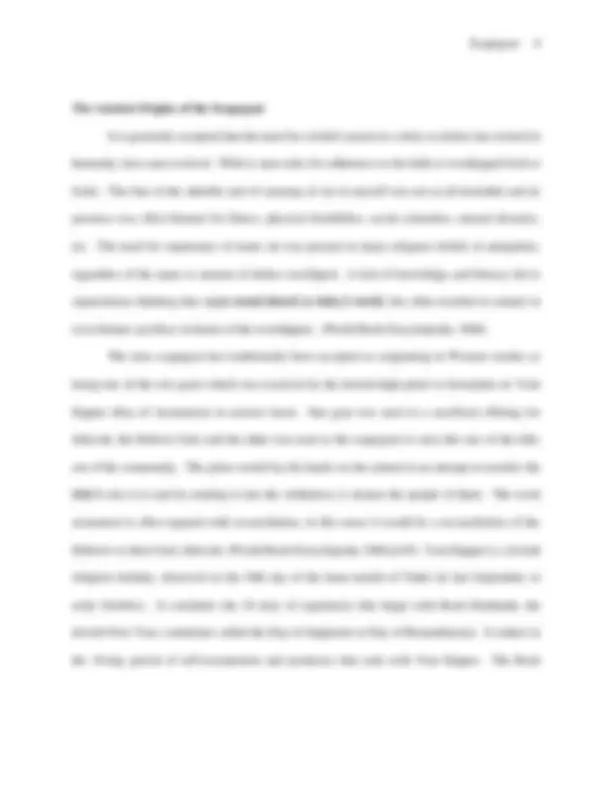
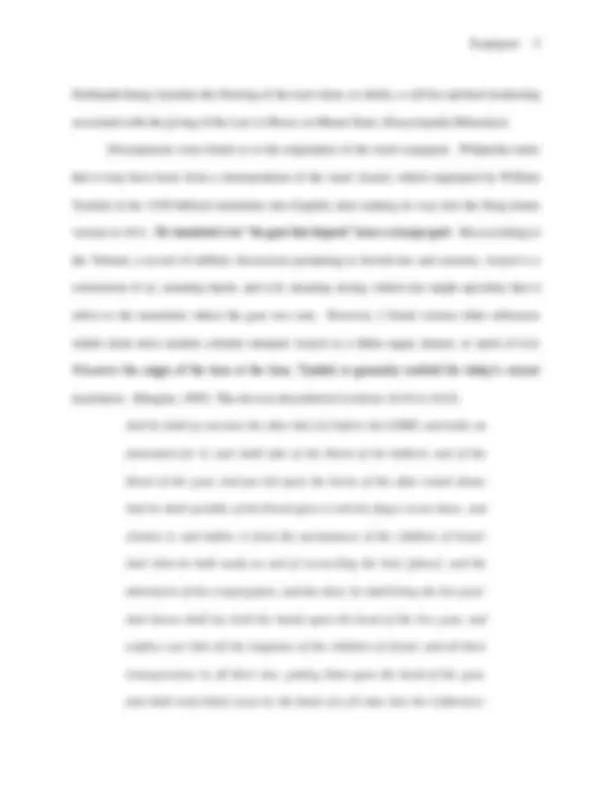

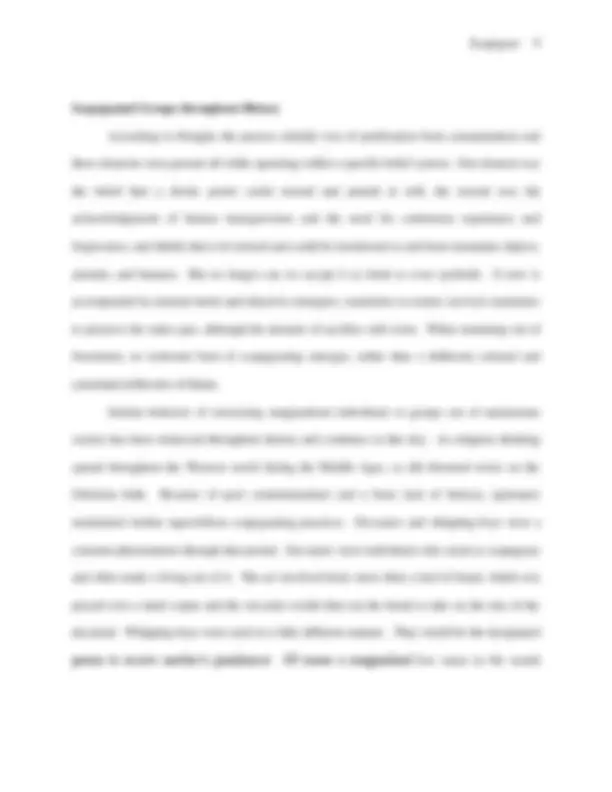
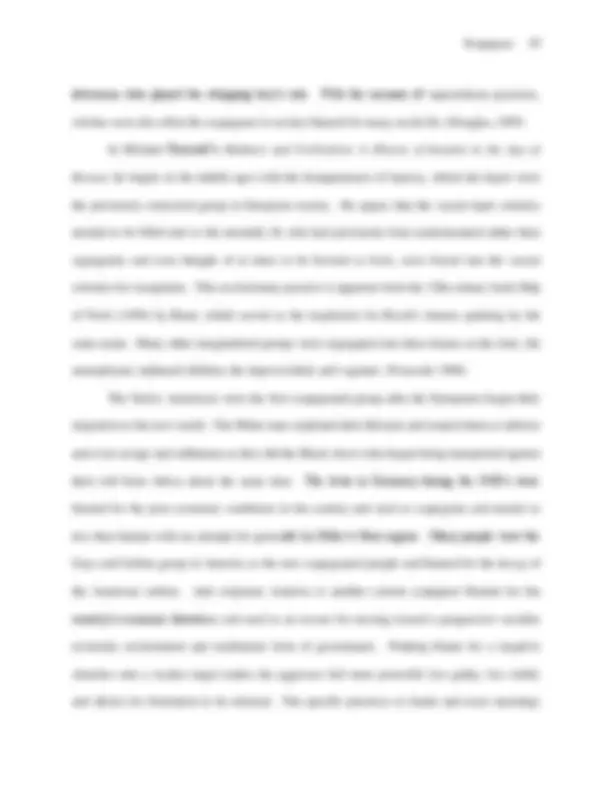
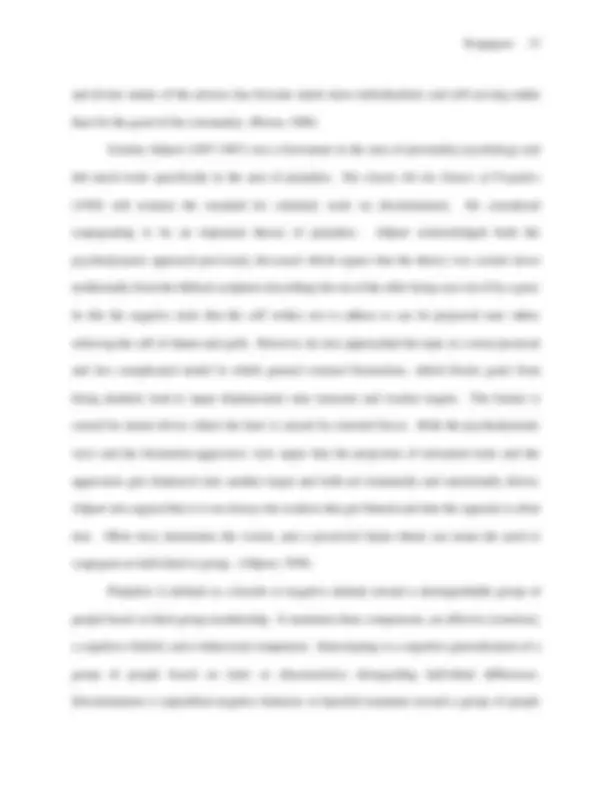
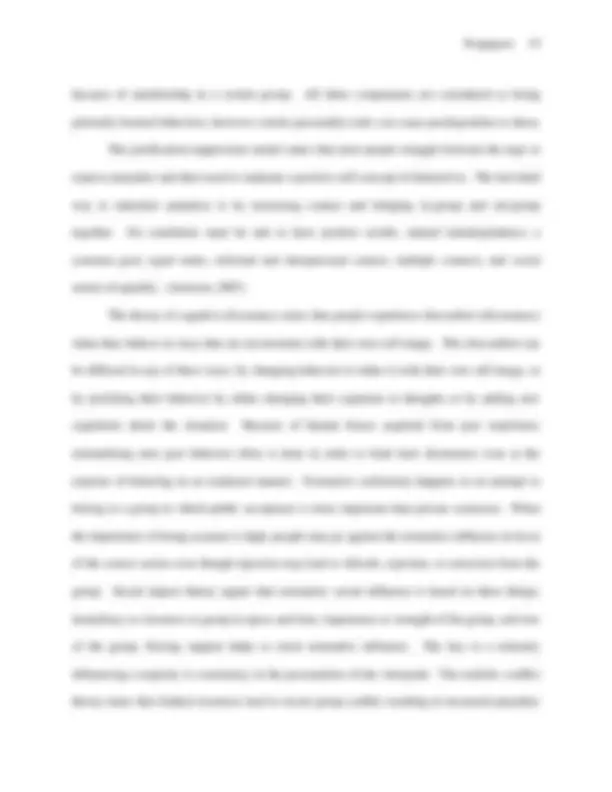
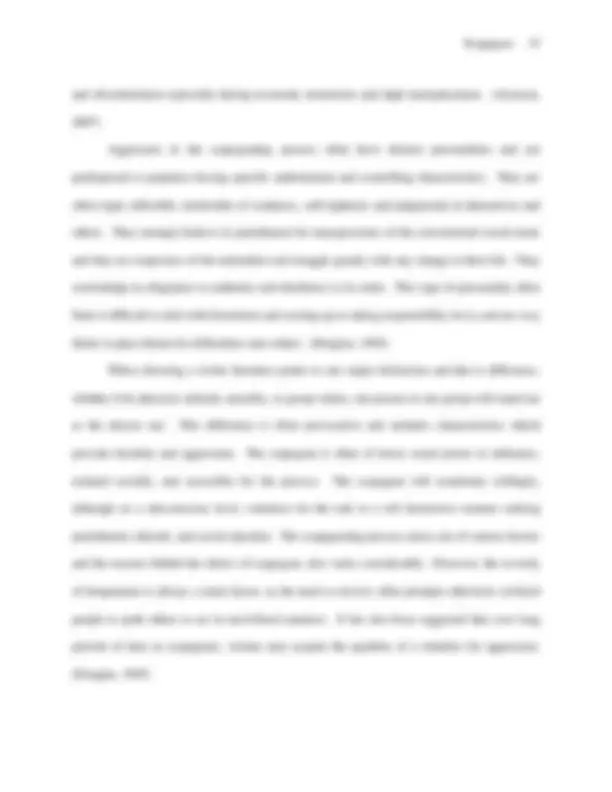
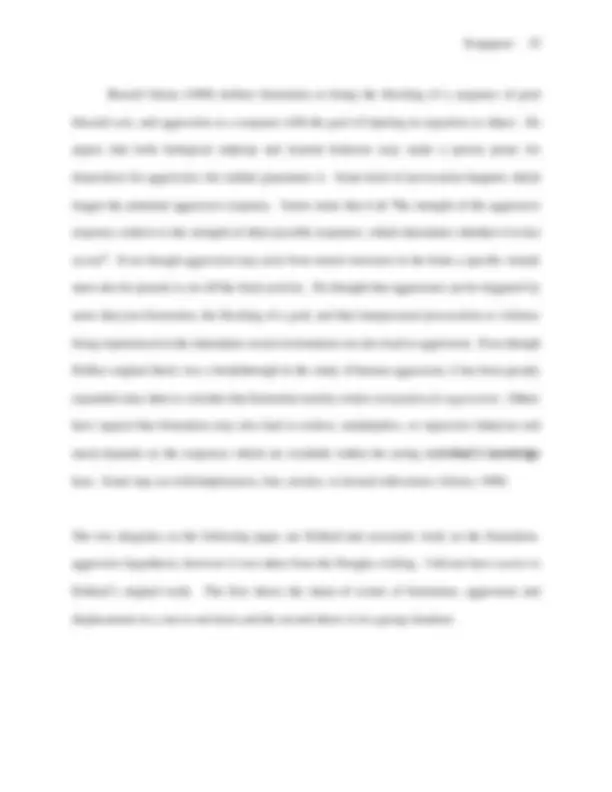
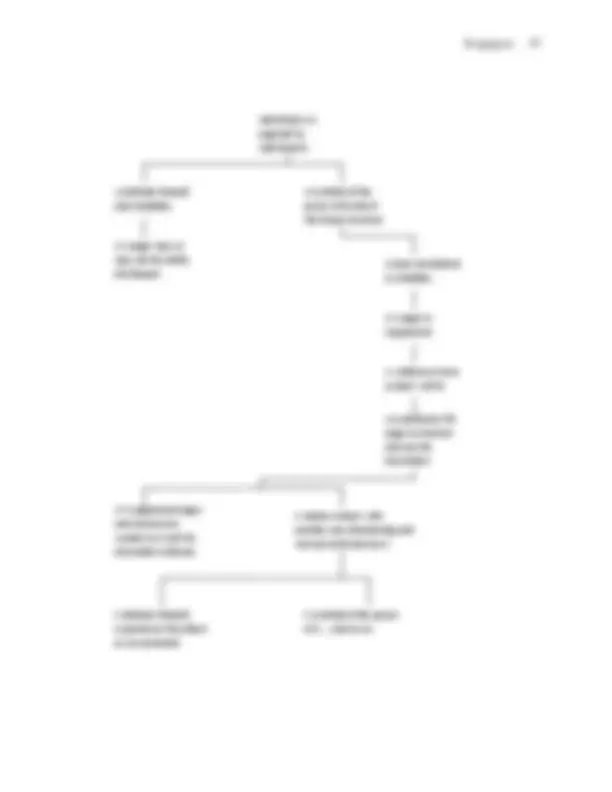
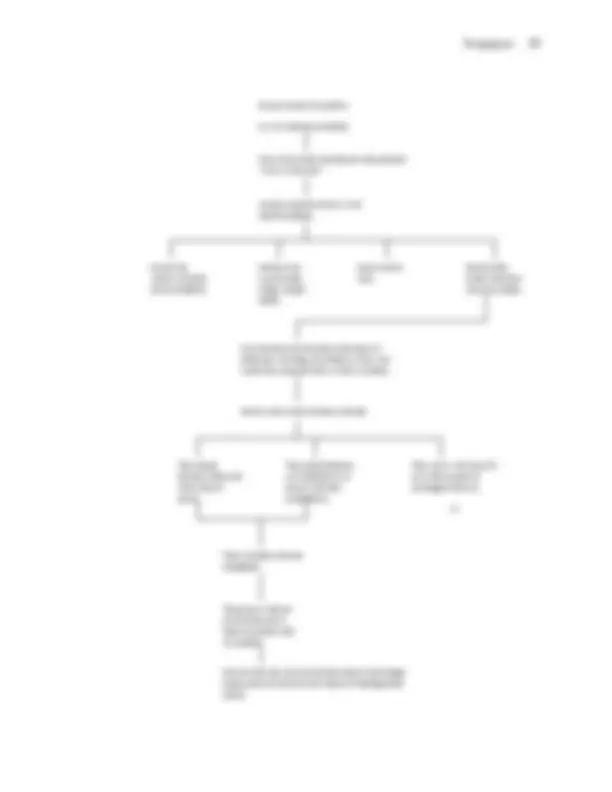
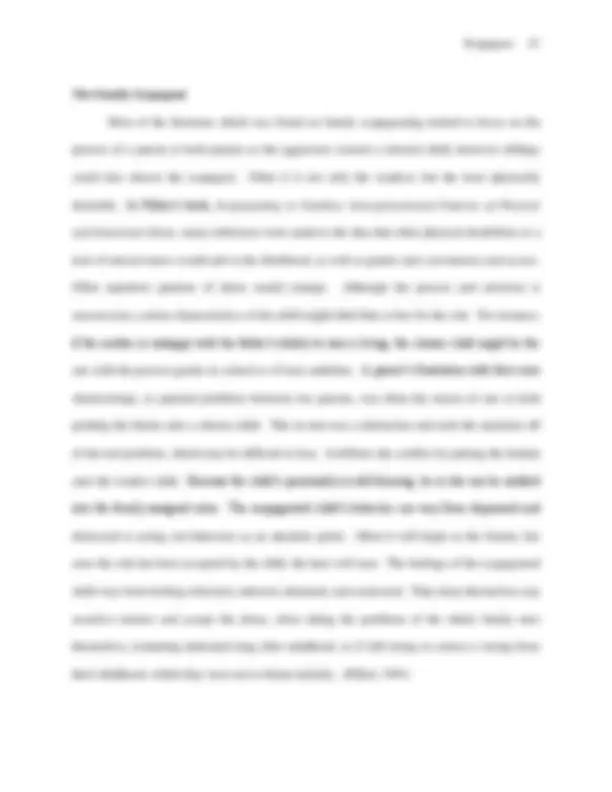
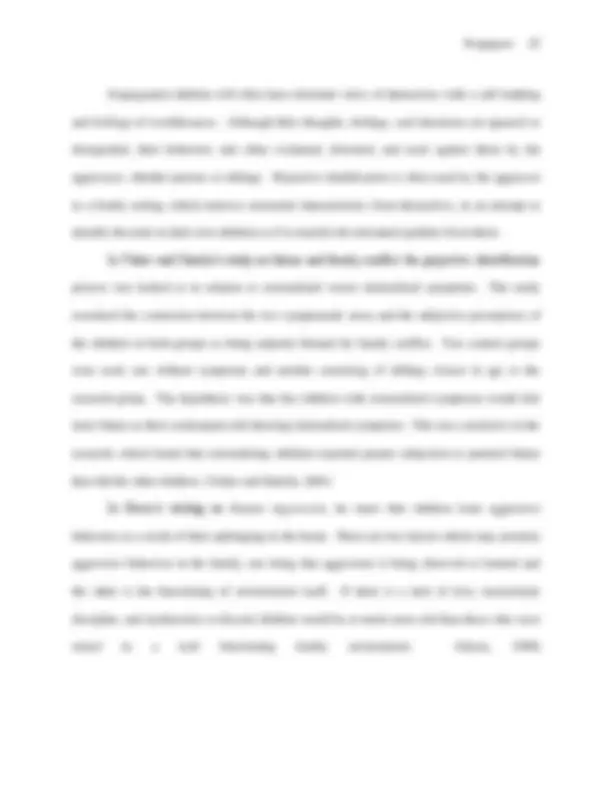
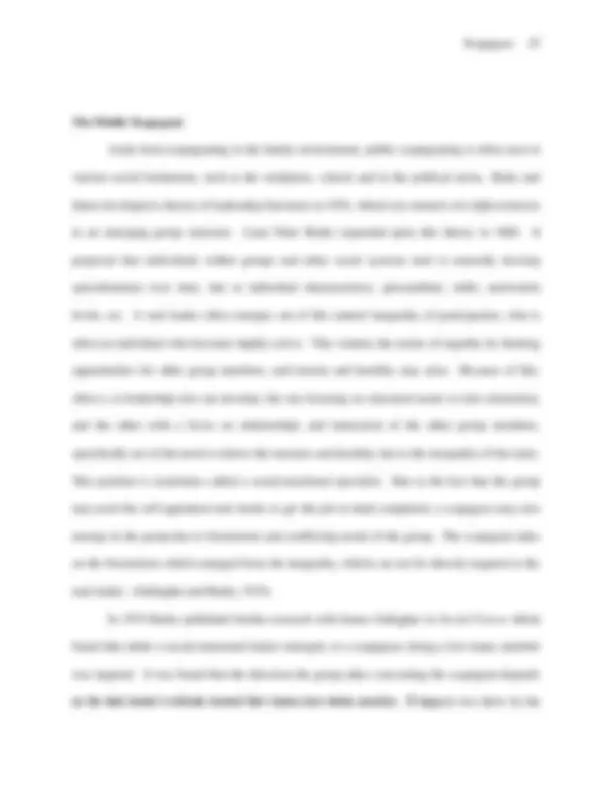
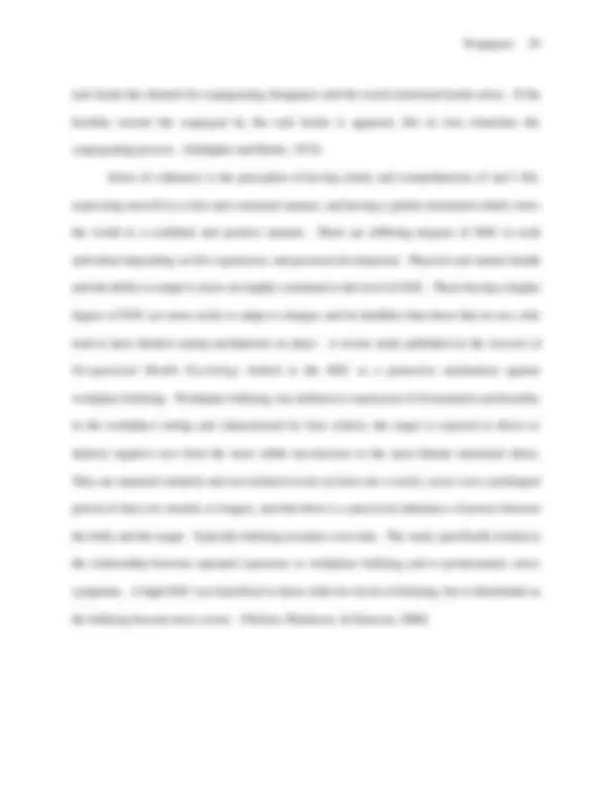

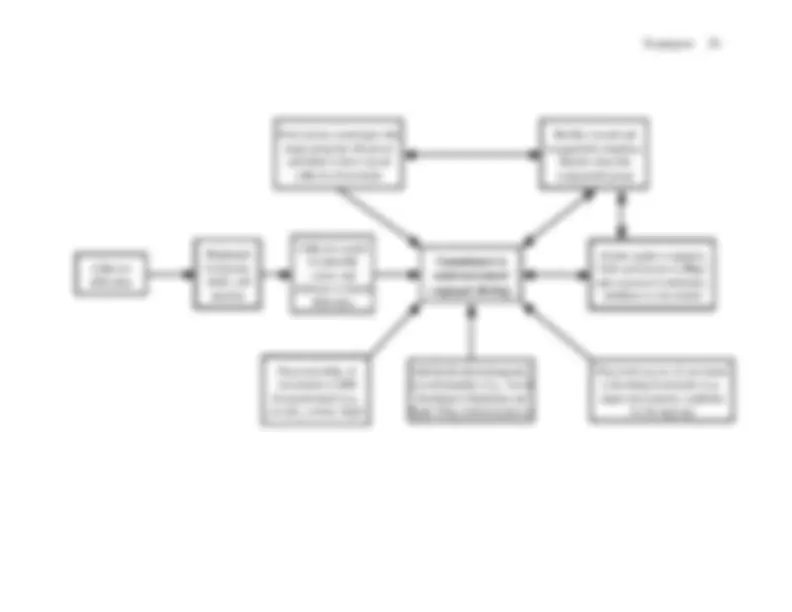

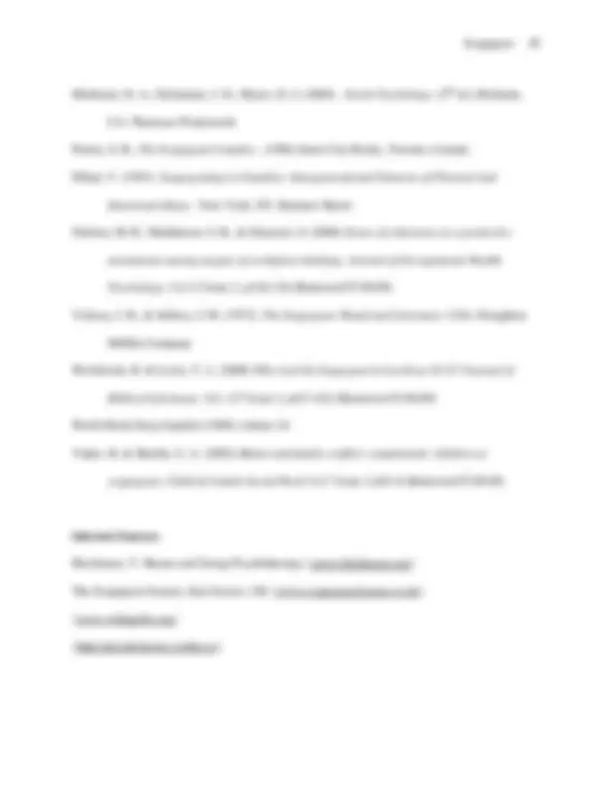


Study with the several resources on Docsity

Earn points by helping other students or get them with a premium plan


Prepare for your exams
Study with the several resources on Docsity

Earn points to download
Earn points by helping other students or get them with a premium plan
Community
Ask the community for help and clear up your study doubts
Discover the best universities in your country according to Docsity users
Free resources
Download our free guides on studying techniques, anxiety management strategies, and thesis advice from Docsity tutors
Scapegoat theory: The psychology of scapegoating and family and public scapegoat from sandra enders regis university.
Typology: Study notes
1 / 28

This page cannot be seen from the preview
Don't miss anything!





















Running Head: Scapegoat
MAPY690 Social Psychology To Juanita Ratner From Sandra Enders Regis University
Abstract This writing looks at the social theory of scapegoating. It reviews the ancient origins of the behavior as well as the historical use in society of scapegoated groups, often the most marginalized or devalued in society, having little means of defending themselves. The writing researches the behavior from both a psychoanalytic perspective and also from a more rational analysis using the frustration-aggression hypothesis of shifting blame and displacing aggression. Related concepts and theories which are closely linked will also be discussed such as projective identification, projection, prejudice, self-fulfilling prophesy, justification-suppression model, cognitive dissonance and social impact theory. A look at the practice within certain social institutions, such as in the family and public arena will also be briefly discussed.
The Ancient Origins of the Scapegoat It is generally accepted that the need for a belief system in a deity or deities has existed in humanity since man evolved. With it came rules for adherence to the faith or worshipped God or Gods. The fear of the afterlife and of carrying of sin in oneself was not at all desirable and its presence was often blamed for illness, physical disabilities, social calamities, natural disasters, etc. The need for repentance of mans sin was present in many religious beliefs in antiquities, regardless of the name or amount of deities worshiped. A lack of knowledge and literacy led to superstitious thinking that might sound absurd in today’s world, but often resulted in animal or even human sacrifices in honor of the worshipped. (World Book Encyclopedia, 1960) The term scapegoat has traditionally been accepted as originating in Western studies as being one of the two goats which was received by the Jewish high priest in Jerusalem on Yom Kippur (Day of Atonement) in ancient Israel. One goat was used in a sacrificial offering for Jehovah, the Hebrew God, and the other was used as the scapegoat to carry the sins of the tribe out of the community. The priest would lay his hands on the animal in an attempt to transfer the tribe’s sins to it and by sending it into the wilderness it cleanse the people of them. The word atonement is often equated with reconciliation, in this sense it would be a reconciliation of the Hebrews to their God, Jehovah. (World Book Encyclopedia 1960 p145) Yom Kippur is a Jewish religious holiday, observed on the 10th day of the lunar month of Tishri (in late September or early October). It concludes the 10 days of repentance that begin with Rosh Hashanah, the Jewish New Year, sometimes called the Day of Judgment or Day of Remembrance. It ushers in the 10-day period of self-examination and penitence that ends with Yom Kippur. The Rosh
Hashanah liturgy includes the blowing of the ram's horn, or shofar, a call for spiritual awakening associated with the giving of the Law to Moses on Mount Sinai. (Encyclopedia Britannica) Discrepancies were found as to the origination of the word scapegoat. Wikipedia states that it may have been from a mistranslation of the word Azazel, which originated by William Tyndale in his 1530 biblical translation into English, later making its way into the King James version in 1611. He translated it as “the goat that departs” hence (e)scape goat. But according to the Talmud, a record of rabbinic discussions pertaining to Jewish law and customs, Azazel is a contraction of az, meaning harsh, and evil, meaning strong, which one might speculate that it refers to the mountains where the goat was sent. However, I found various other references which claim most modern scholars interpret Azazel as a fallen angel, demon, or spirit of evil. Whatever the origin of the term at the time, Tyndale is generally credited for today’s current translation. (Douglas, 1995) The rite was described in Leviticus 16:18 to 16:22: And he shall go out unto the altar that [is] before the LORD, and make an atonement for it; and shall take of the blood of the bullock, and of the blood of the goat, and put [it] upon the horns of the altar round about. And he shall sprinkle of the blood upon it with his finger seven times, and cleanse it, and hallow it from the uncleanness of the children of Israel. And when he hath made an end of reconciling the holy [place], and the tabernacle of the congregation, and the altar, he shall bring the live goat: And Aaron shall lay both his hands upon the head of the live goat, and confess over him all the iniquities of the children of Israel, and all their transgressions in all their sins, putting them upon the head of the goat, and shall send [him] away by the hand of a fit man into the wilderness:
classic writing, The Golden Bough: A Study in Magic and Religion, is a lengthy comparative study of mythology, comparative folklore, superstition, as well as magic, and religion. Frazier was Scottish, although he studied, taught, was published, and died in Britain. The writing was considered scandalous at the time by the British public, because it included the Christian story of Jesus in its comparative study, having a secular tone, and as being a relic of a pagan religion. The text was first published in two volumes in 1890; the third edition, published 1906–15, comprised twelve volumes. Frazer was not widely traveled, with his prime sources of data being ancient histories and questionnaires mailed to missionaries and Imperial officials all over the globe. Below are the topics which were covered in his writing, which elaborated on many cultures through history and around the world, from both developed and undeveloped areas. The need to transfer evil or sin onto others has been practiced socially since antiquities from all walks of life. Due to time restraints I have listed his categorization only, which gives an idea of how in depth his study was. Chapter 55 The Transference of Evil The Transference to Inanimate Objects The Transference to Animals The Transference to Men The Transference of Evil in Europe Chapter 56 The Public Expulsion of Evils The Omnipresence of Demons The Occasional Expulsion of Evils The Periodic Expulsion of Evils Chapter 57 Public Scapegoats The Expulsion of Embodied Evils The Occasional Expulsion of Evils in a Material Vehicle The Periodic Expulsion of Evils in a Material Vehicle On Scapegoats in General Chapter 58 Human Scapegoats in Classical Antiquities The Human Scapegoat in Ancient Rome
The Human Scapegoat in Ancient Greece The Roman Saturnalia
determine who played the whipping boy’s role. With the increase of superstitious practices, witches were also often the scapegoats in society blamed for many social ills. (Douglas, 1995) In Michael Foucault’s Madness and Civilization: A History of Insanity in the Age of Reason , he begins in the middle ages with the disappearance of leprosy, which the lepers were the previously ostracized group in European society. He argues that the vacant leper colonies needed to be filled and so the mentally ill, who had previously been mainstreamed rather than segregated, and even thought of at times to be favored as fools, were forced into the vacant colonies for occupation. This exclusionary practice is apparent from the 15th century book Ship of Fools (1494) by Brant, which served as the inspiration for Bosch's famous painting by the same name. Many other marginalized groups were segregated into these houses at the time, the unemployed, orphaned children, the impoverished, and vagrants. (Foucault, 1988) The Native Americans were the first scapegoated group after the Europeans began their migration to the new world. The White man exploited their lifestyle and treated them as inferior and even savage and subhuman as they did the Black slaves who began being transported against their will from Africa about the same time. The Jews in Germany during the 1930’s were blamed for the poor economic conditions in the country and used as scapegoats and treated as less than human with an attempt for genocide by Hitler’s Nazi regime. Many people view the Gays and lesbian group in America as the new scapegoated people and blamed for the decay of the American culture. And corporate America is another current scapegoat blamed for the country’s economic downturn and used as an excuse for moving toward a progressive socialist economic environment and totalitarian form of government. Pushing blame for a negative situation onto a weaker target makes the aggressor feel more powerful, less guilty, less sinful, and allows for frustration to be released. The specific practices or rituals and exact meanings
may have been changed through the years, but the process still continues. Next I will discuss the psychological process of scapegoating.
and divine nature of the process has become much more individualistic and self-serving rather than for the good of the community. (Perera, 1986) Gordon Allport (1897-1967) was a forerunner in the area of personality psychology and did much work specifically in the area of prejudice. His classic On the Nature of Prejudice (1958) still remains the standard for scholarly work on discrimination. He considered scapegoating to be an important theory of prejudice. Allport acknowledged both the psychodynamic approach previously discussed which argues that the theory was carried down traditionally from the biblical scriptures describing the sin of the tribe being cast out of by a goat. In this the negative traits that the self wishes not to adhere to can be projected onto others relieving the self of shame and guilt. However, he also approached the topic in a more practical and less complicated model in which general external frustrations, which blocks goals from being attained, lead to anger displacement onto innocent and weaker targets. The former is caused by innate drives where the later is caused by external forces. Both the psychodynamic view and the frustration-aggressive view argue that the projection of unwanted traits and the aggression gets displaced onto another target and both are irrationally and emotionally driven. Allport also argued that it is not always the weakest that get blamed and that the opposite is often true. Often envy determines the victim; and a perceived future threat can mean the need to scapegoat an individual or group. (Allport, 1958) Prejudice is defined as a hostile or negative attitude toward a distinguishable group of people based on their group membership. It maintains three components, an affective (emotion), a cognitive (belief), and a behavioral component. Stereotyping is a cognitive generalization of a group of people based on traits or characteristics disregarding individual differences. Discrimination is unjustified negative behavior or harmful treatment toward a group of people
because of membership in a certain group. All three components are considered as being primarily learned behaviors, however certain personality traits can cause predisposition to them. The justification-suppression model states that most people struggle between the urge to express prejudice and their need to maintain a positive self-concept of themselves. The best held way to minimize prejudice is by increasing contact and bringing in-group and out-group together. Six conditions must be met to have positive results; mutual interdependence, a common goal, equal status, informal and interpersonal contact, multiple contacts, and social norms of equality. (Aronson, 2007) The theory of cognitive dissonance states that people experience discomfort (dissonance) when they behave in ways that are inconsistent with their own self image. This discomfort can be diffused in any of three ways; by changing behavior to inline it with their own self image, or by justifying their behavior by either changing their cognition or thoughts or by adding new cognitions about the situation. Because of human biases acquired from past experience rationalizing ones past behavior often is done in order to limit later dissonance even at the expense of behaving in an irrational manner. Normative conformity happens in an attempt to belong to a group in which public acceptance is more important than private assurance. When the importance of being accurate is high, people may go against the normative influence in favor of the correct action even though rejection may lead to ridicule, rejection, or ostracism from the group. Social impact theory argues that normative social influence is based on three things; immediacy or closeness to group in space and time, importance or strength of the group, and size of the group. Having support helps to resist normative influence. The key to a minority influencing a majority is consistency in the presentation of the viewpoint. The realistic conflict theory states that limited resources lead to social group conflict resulting in increased prejudice
The shifting of the blame in the scapegoating process deals with three related concepts, projection, introjection, and projective identification. Projection, in a psychoanalytic sense, is unwanted thoughts and feelings about the self which can be unconsciously projected onto another. This concept can be extended to projection by groups on an individual, or projection by society onto a group. Projection is an especially commonly used defense mechanism in people with certain personality disorders and often used to justify prejudice or evade responsibility. Introjection is the process in which the individual unconsciously incorporates another’s qualities, values, or attitudes, or part of another’s personality into their own self. This process can be normal such as taking on parental values or attitudes, but can also be used as a defense mechanism in situations which arouse anxiety. Projective identification is the actual internalization of the projection process, through conscious or unconscious interpersonal pressure, the receiver of the projected qualities, actually believes them and internalizes them. This term was first used by Melanie Klein in 1946 in the object relations theory, by which the object of projection was used in order to control or harm it. Projective Identification is thought to be a fairly primitive psychological process and defense mechanism; however it is also known to be at the root of more advanced cognition such as empathy or intuition. So in a sense it can be used as a double-edged sword in a positive or negative light. Self-fulfilling prophecy is a very similar sociological theory coined by Robert Merton in his Social Theory and Social Structure (1949) classic which states that a declared prophecy can have the influence on the individual or others if it is believed to be true. It extends an expectation of what another person (or group) is like prematurely judging that person and that person acts in the manner consistent with the behavior. Similar theories exist in the field of education such as the pygmalion theory and the soft bigotry of low expectations. (APA Dictionary of Psychology, 2007)
In 1939 John Dollard (and his associates Miller, Doob, and Mowrer), published a classic argument on aggression in Frustration and Aggression. This theory of frustration-aggression proposed that frustration always produces an aggressive urge and that aggression is always the result of frustration. This writing was the first major systematic study concerning human aggression in psychology and it was the first to speak of displacing aggression onto another. Miller later noted that the urge for aggression will increase as the thwarting of the goal continued and the more similar the provocateur and target. Frustration can be caused by the prevention of a goal with an individual or group. Internal forces of frustration can include motivational conflicts and inhibitions and external forces can include the actions of other individuals or by the rules of society. Leonard Berkowitz later proposed in 1989 that the frustration must be decidedly unpleasant in order to trigger an aggressive response. (APA Dictionary) Although this thesis has since been challenged often since Dollard and his associates, it remains a highly studied area in social psychology. In 2000 the Journal of Personality and Social Psychology published a meta-analytic review of Dollard’s original work and the inclusion of his thesis in social psychology textbooks since his work was published. The study looked at 122 texts from 1939 to 2000 and found a decline through the years most likely due to challenges to the theory. However, the study found validity to the original work arguing that it is still a highly regarded area of study. Marcus-Newhall and her associates in the study found that the more negative the setting in which the participant and target interacted, the greater the magnitude of displaced aggression. In accordance with Miller, the higher similarity between the provocateur and target, the more displaced aggression. And consistent with Berkowitz, the intensity of initial provocation is inversely related to the magnitude of the displaced aggression. (Marcus-Newhall, 2000)
Individual A is angered by individual B
A defends himself and retaliates.
A’s anger may or may not be totally discharged.
A is afraid of the power of B and of the threat involved.
A does not defend or retaliate. A’s anger is suppressed. A withdraws from contact with B. A experiences his anger as tension and psychic discomfort.
A’s suppressed anger and tension are vented on C and his discomfort relieved.
A makes contact with another non-threatening and non-powerful person C.
C defends himself; experiences the attack as unwarranted.
C is afraid of the power of A … and so on.
Group is aware of problem; e.g. it is making no progress, stagnation, constant bickering, etc. One or two of the members ask the question, “Why is it like this?”
Usually a realistic answer is not readily available.
Group tries various remedies and exhortations.
Carries on as usual hoping things will get better.
Seeks outside help. Decides that certain members may be to blame.
Such members are selected on the basis of difference, resisting, provocation, dislike, non- conformity, powerlessness, or they volunteer. Blame is laid on the members selected.
They accept because of fear and known lack of power.
They accept because such treatment is in accord with their expectations.
They resist serve the purpose of – this may still discharge of tension, or may result in others being chosen. These members become scapegoats.
The group is relieved of its tension and is freed to proceed with its purposes. One of which may be to look at the process of discharge of group tension and to devise means of locating actual causes.